Wave Simulation by the SWAN Model and FVCOM Considering the Sea-Water Level around the Zhoushan Islands
Abstract
:1. Introduction
2. Dataset Collection and Methods
3. Results
3.1. Simulation of Sea-Surface Current
3.2. Simulation of Sea-Water Level
3.3. Simulation of Significant Wave Height
4. Discussion
5. Conclusions
Author Contributions
Funding
Acknowledgments
Conflicts of Interest
Appendix A
Appendix B
References
- Buonaiuto, F.S.; Slattery, M.; Bokuniewicz, H.J. Wave modeling of long island coastal waters. J. Coastal Res. 2011, 27, 470–477. [Google Scholar]
- Wang, Z.F.; Zhou, L.B.; Dong, S.; Wu, L.Y.; Li, Z.B.; Mu, L.; Wang, A.F. Wind wave characteristics and engineering environment of the South China Sea. J. Ocean U. China 2014, 13, 893–900. [Google Scholar] [CrossRef]
- Liu, Q.X.; Babanin, A.; Fan, Y.; Zieger, S.; Guan, C.L.; Moon, I.J. Numerical simulations of ocean surface waves under hurricane conditions: Assessment of existing model performance. Ocean Model. 2017, 18, 73–79. [Google Scholar] [CrossRef]
- Wang, N.; Hou, Y.J.; Li, S.Q.; Li, R. Numerical simulation and preliminary analysis of typhoon waves during three typhoons in the Yellow Sea and east China Sea. J. Oceanol. Limn. 2019, 37, 1805–1816. [Google Scholar] [CrossRef]
- Zhou, L.M.; Li, Z.B.; Mu, L.; Wang, A.F. Numerical simulation of wave field in the South China Sea using WAVEWATCH III. Chin. J. Oceanol. Limn. 2014, 37, 656–664. [Google Scholar] [CrossRef]
- Rogers, W.E.; Hwang, P.A.; Wang, D.W. Investigation of wave growth and decay in the SWAN model: Three regional-scale applications. J. Phys. Oceanogr. 2003, 33, 366–389. [Google Scholar] [CrossRef]
- Bi, F.; Song, J.B.; Wu, K.J.; Xu, Y. Evaluation of the simulation capability of the Wavewatch III model for Pacific Ocean wave. Acta Oceanol. Sin. 2015, 34, 43–57. [Google Scholar] [CrossRef]
- Mentaschi, L.; Besio, G.; Cassola, F.; Mazzino, A. Performance evaluation of Wavewatch IIIi in the Mediterranean Sea. Ocean Modell. 2015, 90, 82–94. [Google Scholar] [CrossRef]
- Akpınar, A.; Vledder, G.; Kömürcü, M.; Özger, M. Evaluation of the numerical wave model (SWAN) for wave simulation in the Black Sea. Cont. Shelf Res. 2012, 50, 80–99. [Google Scholar]
- Rusu, L.; Soares, C.G. Wave energy assessments in the Azores islands. Renew. Energ. 2012, 45, 183–196. [Google Scholar] [CrossRef]
- Bottema, M.; Vledder, G.V. Effective fetch and non-linear four-wave interactions during wave growth in slanting fetch conditions. Coast. Eng. 2008, 55, 261–275. [Google Scholar] [CrossRef]
- Dragani, W.C.; Garavento, E.; Simionato, C.G.; Nunez, M.N.; Martin, P.; Campos, M.I. Wave simulation in the outer Rio de la Plata estuary: Evaluation of SWAN model. J. Waterw. Port C-ASCE. 2008, 5, 299–305. [Google Scholar] [CrossRef]
- Moeini, M.H.; Etemad-Shahidi, A. Wave parameter hindcasting in a lake using the SWAN model. Sci. Iran. 2009, 16, 156–164. [Google Scholar]
- Young, I.R.; Vledder, G. A review of the central role of nonlinear interactions in wind-wave evolution. Phil. Trans. Roy. Soc. Lond. 1993, 342, 505–524. [Google Scholar]
- Young, I.R. Observations of the spectra of hurricane generated waves. Ocean Eng. 1998, 25, 261–276. [Google Scholar] [CrossRef]
- Cui, H.; He, H.L.; Liu, X.H.; Li, Y. 2012. Effect of oceanic current on typhoon-wave modeling in the East China Sea. Chin. Phys. B. 2012, 21, 109201. [Google Scholar] [CrossRef]
- Sheng, Y.P.; Alymov, V.; Paramygin, V.A. Simulation of storm surge, wave, currents, and inundation in the outer banks and Chesapeake Bay during Hurricane Isabel in 2003: The importance of waves. J. Geophys. Res. 2010, 115, C04008. [Google Scholar] [CrossRef]
- Dietrich, J.C.; Tanaka, S.; Westerink, J.J.; Dawson, C.N.; Luettich, R.A.; Zijlema, M.; Holthuijsen, L.H.; Smith, J.M.; Westerink, L.G.; Westerink, H.J. Performance of the unstructured-mesh, SWAN+ ADCIRC model in computing hurricane waves and surge. J. Sci. Comput. 2012, 52, 468–497. [Google Scholar] [CrossRef]
- Chen, C.S.; Liu, H.; Beardsley, R.C. An unstructured, finite-volume, three-dimensional, primitive equation ocean model: Application to coastal ocean and estuaries. J. Atmos. Ocean. Tech. 2003, 20, 159–186. [Google Scholar] [CrossRef]
- Pringle, J.M. Sources of variability in Gulf of Maine circulation, and the observations needed to model it. Deep-Sea Res. PT. II. 2006, 53, 2457–2476. [Google Scholar] [CrossRef]
- Huang, H.; Chen, C.L.; Cowles, G.W.; Winant, C.D.; Beardsley, R.C.; Hedstrom, K.S. Haidvogel, D.B. FVCOM validation experiments: Comparisons with ROMS for three idealized barotropic test problems. J. Geophys. Res. 2008, 113, C07042. [Google Scholar] [CrossRef] [Green Version]
- Chen, C.S.; Huang, H.; Beardsley, R.C.; Liu, H.; Xu, Q.; Cowles, G. A finite-volume numerical approach for coastal ocean circulation studies: Comparisons with finite difference models. J. Geophys. Res. 2007, 112, C03018. [Google Scholar] [CrossRef]
- Ma, Z.; Han, G.; De Young, B. Oceanic responses to Hurricane Igor over the Grand Banks: A modeling study. J. Geophys. Res. 2015, 120, 1276–1295. [Google Scholar] [CrossRef]
- Sun, Y.J.; Perrie, W.; Toulany, B. Simulation of wave-current interactions under hurricane conditions using an unstructured-grid model: Impacts on ocean waves. J. Geophys. Res. 2018, 123, 3739–3760. [Google Scholar] [CrossRef]
- Dukhovskoy, D.S.; Morey, S.L. Simulation of the Hurricane Dennis storm surge and considerations for vertical resolution. Nat. Hazards 2011, 58, 511–540. [Google Scholar] [CrossRef]
- Sheng, Y.X.; Shao, W.Z.; Li, S.Q.; Zhang, Y.M.; Yang, H.W.; Zuo, J.C. Evaluation of typhoon waves simulated by WaveWatch-III model in shallow waters around Zhoushan Islands. J. Ocean U. China 2019, 18, 365–375. [Google Scholar] [CrossRef]
- Shao, W.Z.; Sheng, Y.X.; Li, H.; Shi, J.; Ji, Q.Y.; Tan, W.; Zuo, J.C. Analysis of wave distribution simulated by WAVEWATCH-III model in typhoons passing Beibu Gulf, China. Atmosphere 2018, 9, 265. [Google Scholar] [CrossRef] [Green Version]
- Hu, Y.Y.; Shao, W.Z.; Shi, J.; Sun, J.; Ji, Q.Y.; Cai, L.N. Analysis of the typhoon wave distribution simulated in WAVEWATCH-III model in the context of Kuroshio and wind-induced current. J. Oceanol. Limn. 2020. [Google Scholar] [CrossRef]
- Moon, I.J. Impact of a coupled ocean wave-tide-circulation system on coastal modeling. Ocean Model. 2005, 8, 203–236. [Google Scholar] [CrossRef]
- Masson, D. A case study of wave-current interaction in a strong tidal current. J. Phys. Oceanogr. 1996, 26, 359–372. [Google Scholar] [CrossRef] [Green Version]
- Chen, T.Q.; Zhang, Q.H.; Wu, Y.S.; Ji, C.; Yang, J.S.; Liu, G.W. Development of a wave-current model through coupling of FVCOM and SWAN. Ocean Eng. 2018, 164, 443–454. [Google Scholar] [CrossRef]
- Lv, X.; Yuan, D.; Ma, X.; Tao, J. Wave characteristics analysis in Bohai Sea based on ECMWF wind field. Ocean Eng. 2014, 91, 159–171. [Google Scholar] [CrossRef]
- Kamranzad, B.; Etemad-Shahidi, A.; Chegini, V.; Yeganeh-Bakhtiary, A. Climate change impact on wave energy in the Persian Gulf. Ocean Dynam. 2015, 65, 777–794. [Google Scholar] [CrossRef] [Green Version]
- Zheng, K.W.; Sun, J.; Guan, C.L.; Shao, W.Z. Analysis of the global swell and wind-sea energy distribution using WAVEWATCH III. Adv. Meteorol. 2016, 7, 1–9. [Google Scholar] [CrossRef] [Green Version]
- Zheng, K.W.; Osinowo, A.; Sun, J.; Hu, W. Long term characterization of sea conditions in the East China Sea using significant wave height and wind speed. J. Ocean U. China 2018, 17, 733–743. [Google Scholar] [CrossRef]
- Hu, Y.Y.; Shao, W.Z.; Wei, Y.L.; Zuo, J.C. Analysis of typhoon-induced waves along typhoon tracks in the Western North Pacific Ocean, 1998–2017. J. Mar. Sci. Eng. 2020, 8, 521. [Google Scholar] [CrossRef]
- Wang, K.; Hou, Y.J.; Li, S.Q.; Li, R. Numerical study of storm surge inundation in the southwestern Hangzhou bay region during Typhoon Chan-Hom in 2015. J. Ocean U. China 2020, 19, 263–271. [Google Scholar] [CrossRef]
- Ding, Y.; Yao, Z.G.; Zhou, L.L.; Bao, M.; Zang, Z.C. Numerical modeling of the seasonal circulation in the coastal ocean of the Northern South China Sea. Front. Earth Sci. 2018, 14, 90–109. [Google Scholar] [CrossRef]
- Ou, S.H.; Liau, J.M.; Hsu, T.W.; Tzang, S.Y. Simulating typhoon waves by SWAN wave model in coastal waters of Taiwan. Ocean Eng. 2002, 29, 947–971. [Google Scholar] [CrossRef]
- Yuan, X.; Wood, E.F.; Luo, L.F.; Pan, M. A first look at Climate Forecast System Version 2 (CFSv2) for hydrological seasonal prediction. Geophys. Res.Lett. 2011, 38, L13402. [Google Scholar] [CrossRef] [Green Version]
- Zhuang, W.; Wang, D.X.; Wu, R.S. Coastal upwelling off eastern Fujian\|Guangdong detected by remote sensing. Chin. J. Atmos. Sci. 2005, 29, 438–444. [Google Scholar]
- Zhang, H.F.; Wu, Q.; Chen, G. Validation of HY-2A remotely sensed wave heights against buoy data and Jason-2 altimeter measurements. J. Atmos. Ocean. Tech. 2015, 32, 1270–1280. [Google Scholar] [CrossRef]
- Chu, P.C.; Qi, Y.; Chen, Y.; Shi, P.; Mao, Q. South China Sea wind-wave characteristics. Part I: Validation of Wavewatch-III using TOPEX/Poseidon data. J. Atmos. Ocean. Tech. 2004, 21, 1718–1733. [Google Scholar] [CrossRef] [Green Version]
- Lin, Y.; Dong, S.; Wang, Z.; Guedes Soares, C. Wave energy assessment in the china adjacent seas on the basis of a 20-year SWAN simulation with unstructured grids. Renew. Energ. 2019, 136, 275–295. [Google Scholar] [CrossRef]
- Wu, H.; Du, M.; Wang, X.Y.; Meng, J. Study on hydrography and small-scale process over Zhoushan sea area. J. Ocean U. China 2015, 14, 829–834. [Google Scholar] [CrossRef]
- Stopa, J.E.; Cheung, K.F. Intercomparison of wind and wave data from the ECMWF reanalysis interim and the NECP climate forecast system reanalysis. Ocean Model. 2014, 75, 65–83. [Google Scholar] [CrossRef]
- Shen, Z.B.; Wu, X.B.; Fei, Y.J.; Xu, X.A.; Chen, X.F. Surface tidal currents in the open sea area to the east of the Zhoushan Islands measured with high frequency surface wave radar. Acta Oceanol. Sin. 2013, 32, 5–10. [Google Scholar] [CrossRef]
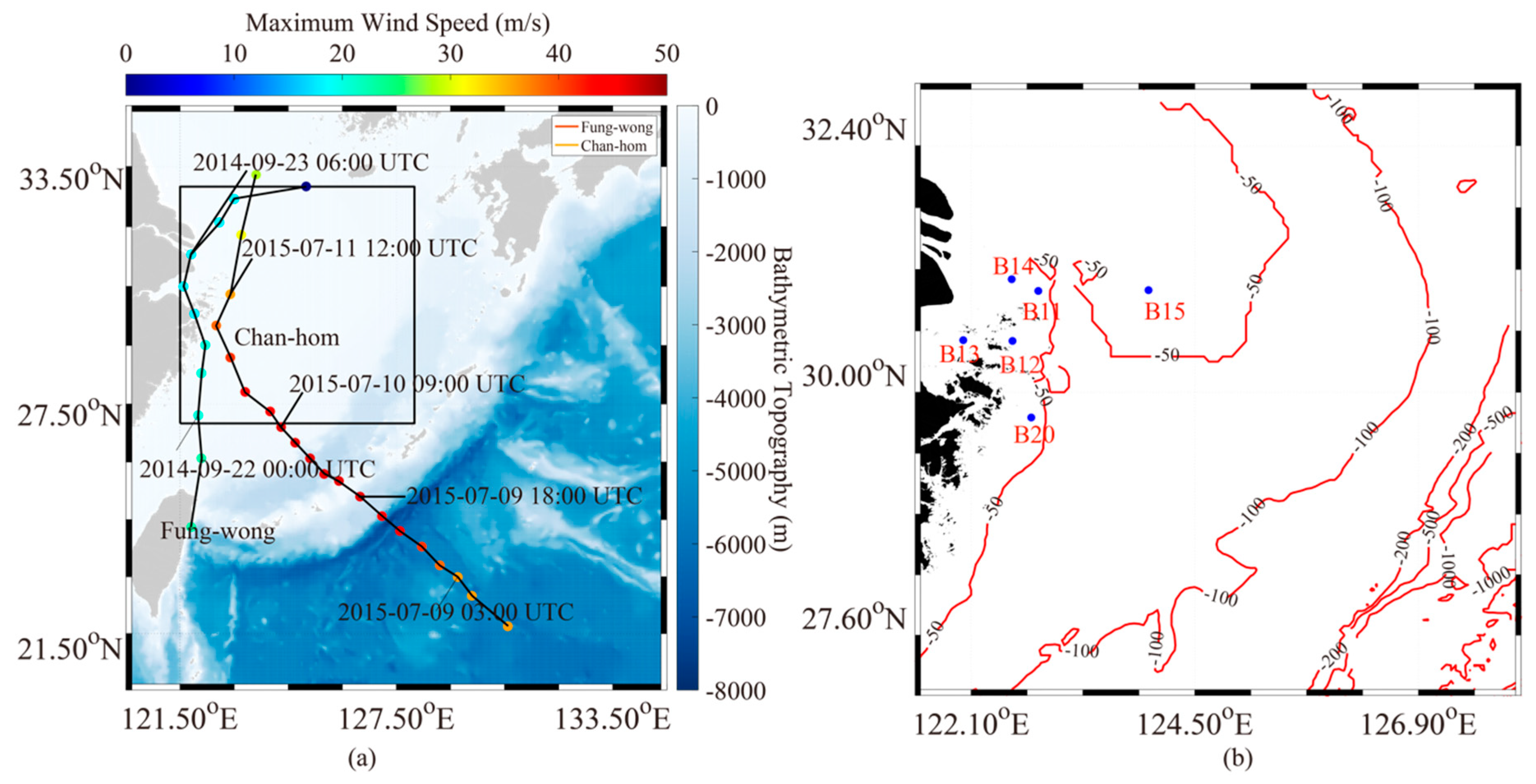






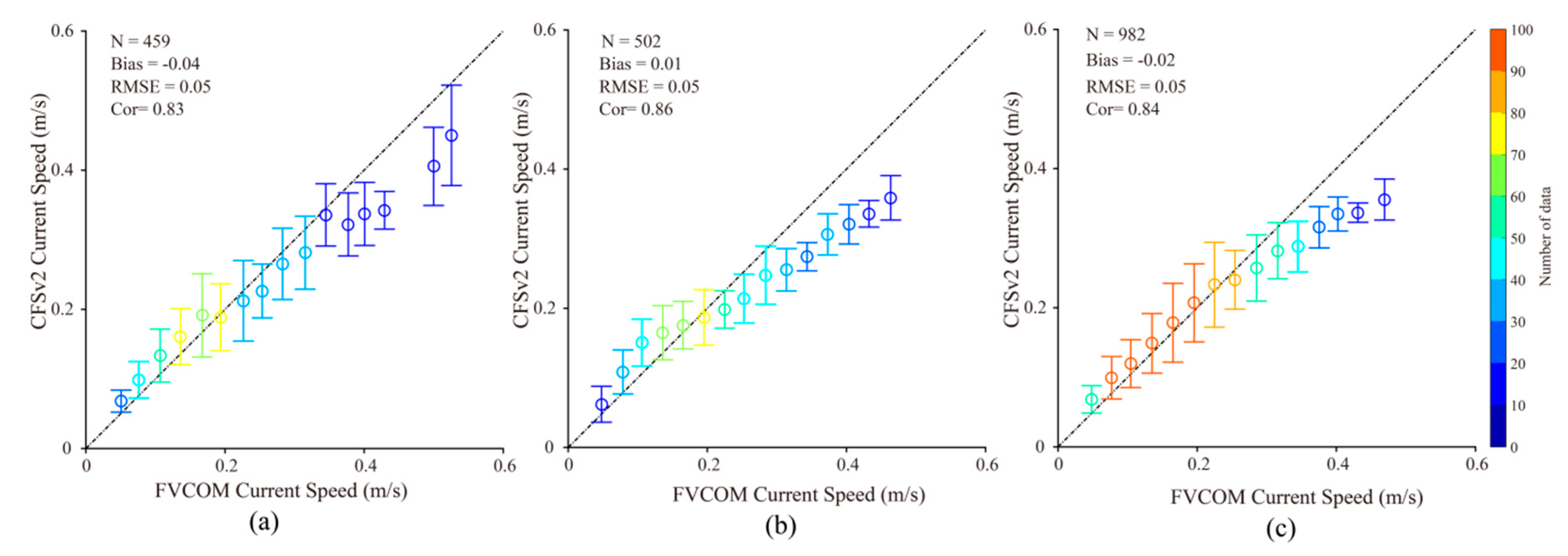


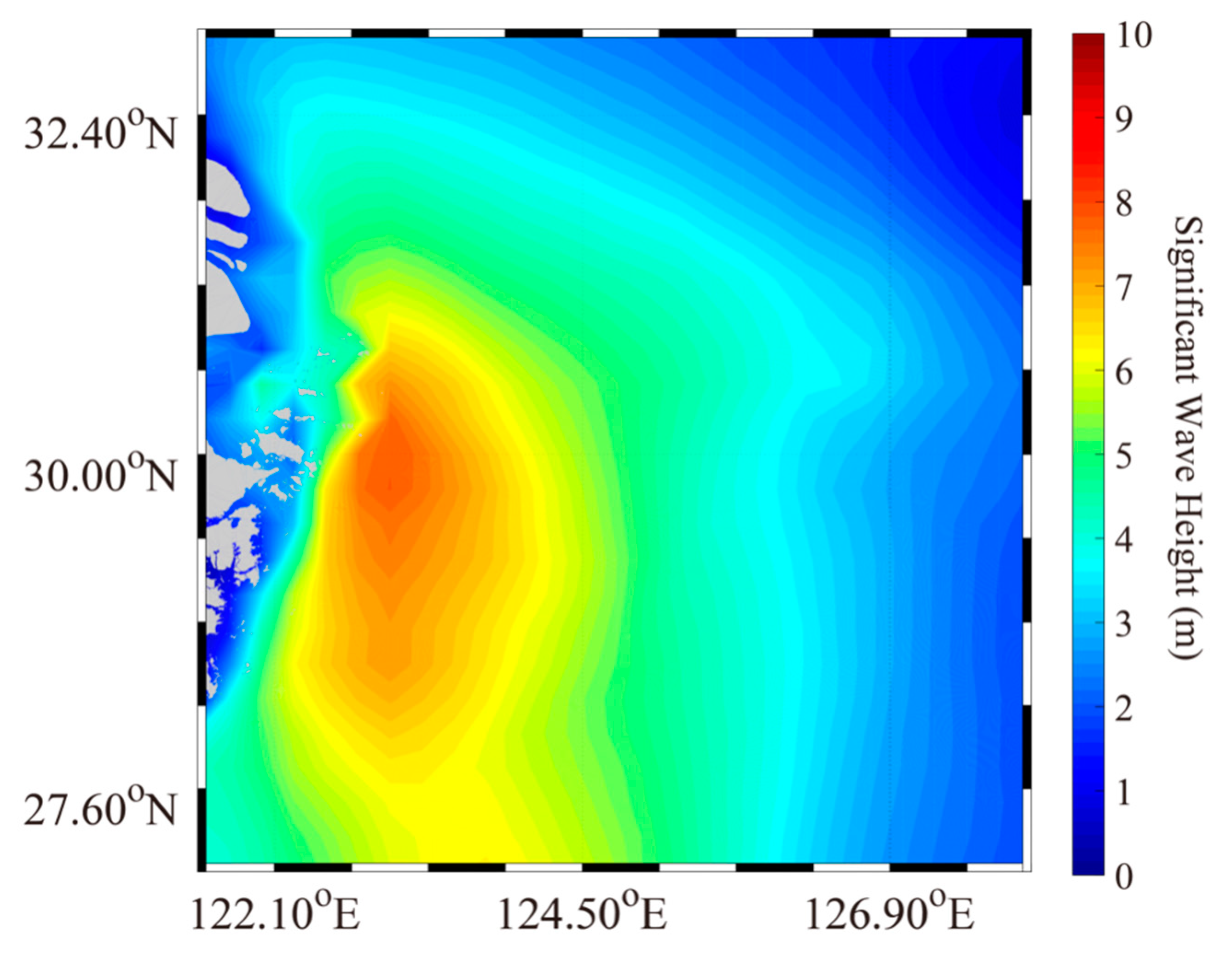
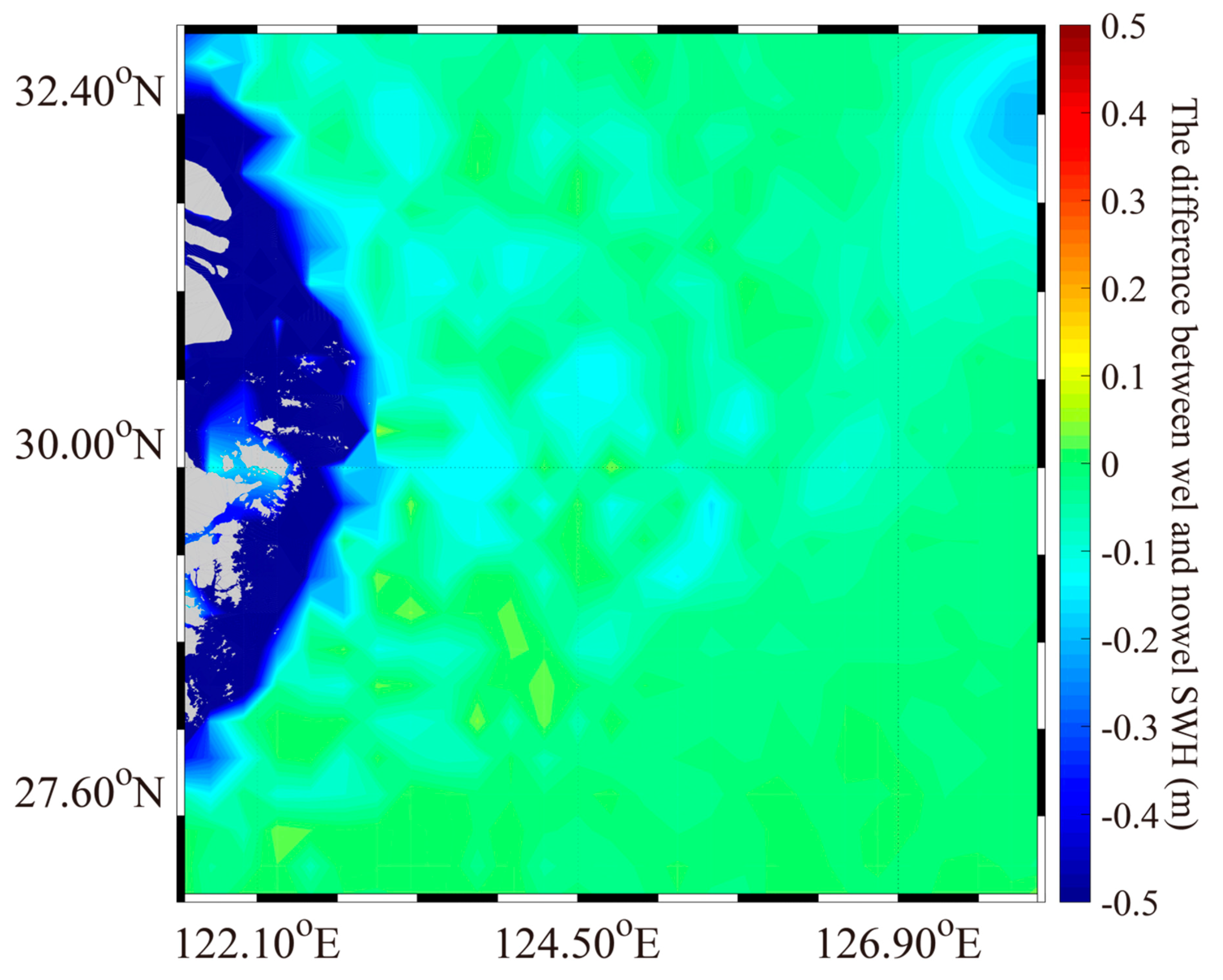


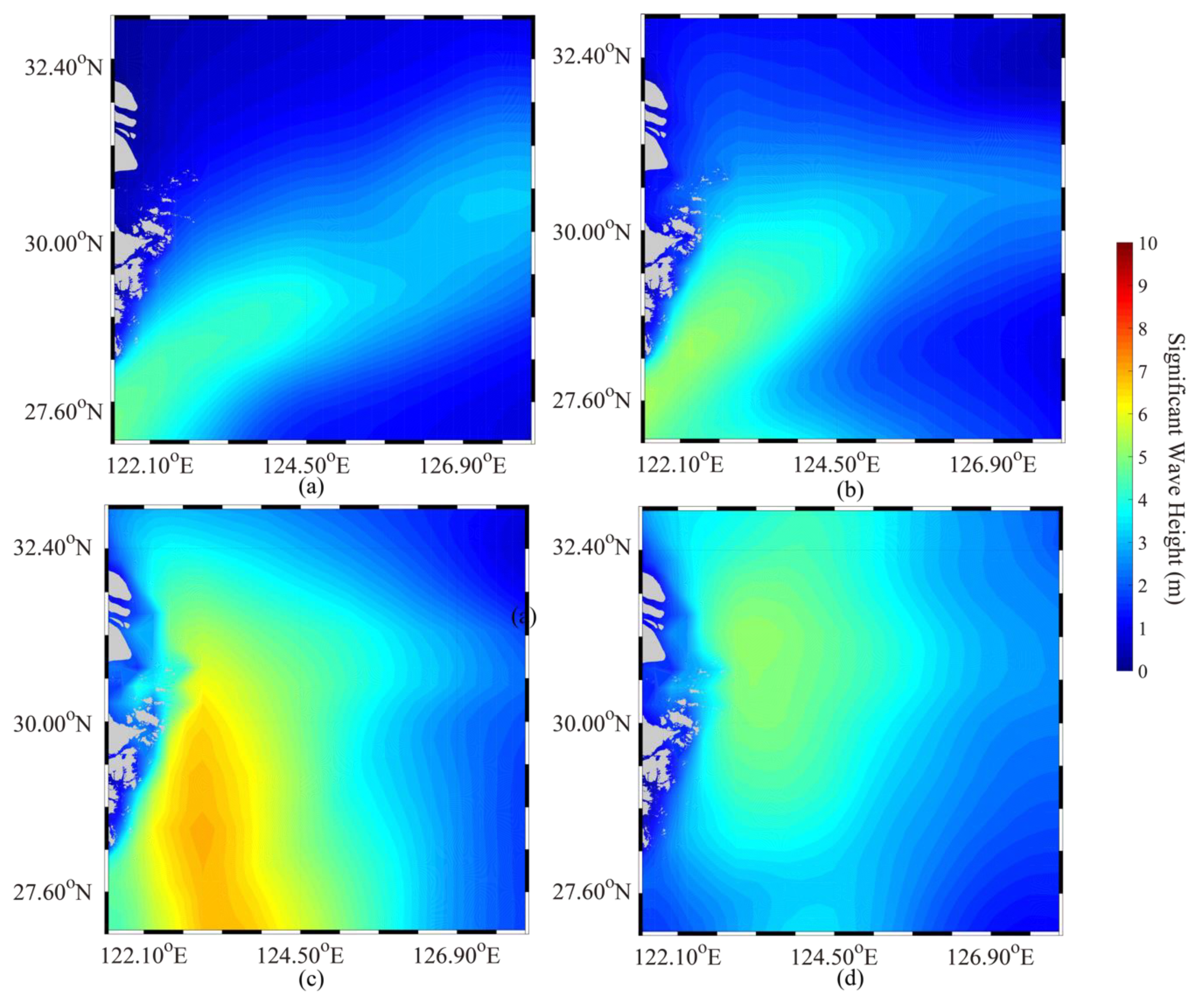
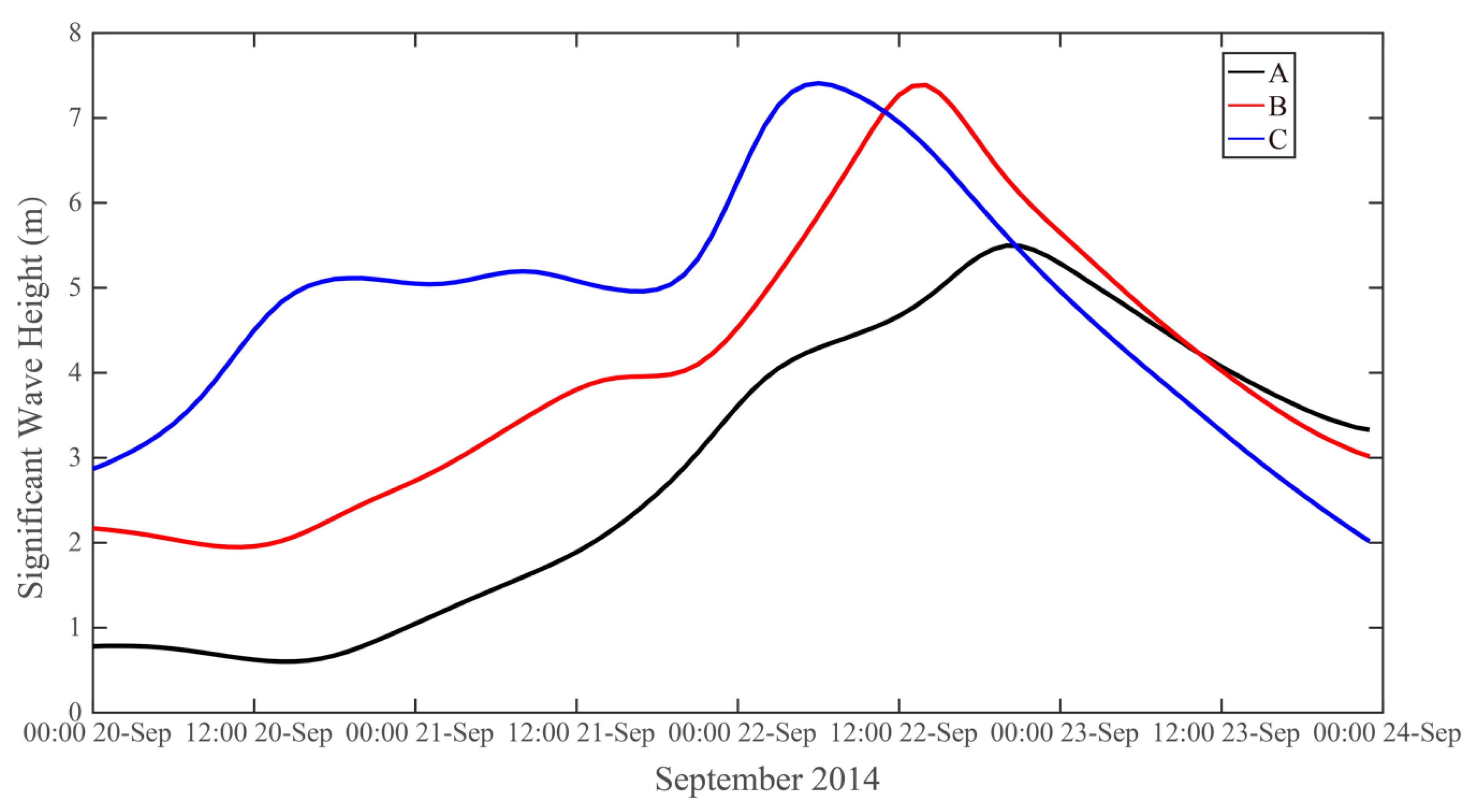
| Forcing field | Holland-European Centre for Medium-Range Weather Forecasts (ECMWF) (H-E) wind with a spatial resolution of 0.125° and time interval of six hours |
| Open boundary | Water-tide data from TPOX.5; sea-surface temperature, sea-surface salinity, and sea-surface current values at 60-min intervals at a 1/12° (~8 km) grid spatial resolution from the HYbrid Coordinate Ocean Model (HYCOM) |
| Resolution | Triangular terrain grid with a 60-min temporal resolution |
| Forcing field | H-E wind with a spatial resolution of 0.125° and time interval of six hours; current speed simulated by the FVCOM |
| Frequency bins | Logarithmic, between 0.01 and 1, at intervals of Δf/f = 0. 0.903 |
| Resolution | 0.1° grid with a 30-min temporal resolution |
| Bulk formula | Bulk formula in [39] employed for including the white capping induced by the high wind speed |
| Directional resolution | 10° grid ranged from 0° to 360° |
| Propagation scheme | WESTHuysen (non-linear saturation-based white-capping combined with wind) |
| Bottom friction | JONSWAP with a constant friction coefficient |
| Other settings | Wave interactions (QUADrupl); triad wave–wave interactions (TRIad) |
| ID: B11 | ID: B12 | ID: B13 | ID: B14 | ID: B15 | ID: B20 | |
|---|---|---|---|---|---|---|
| RMSE | 0.84 | 0.64 | 0.79 | 0.84 | 0.88 | 0.75 |
| Cor | 0.92 | 0.93 | 0.84 | 0.94 | 0.85 | 0.94 |
| Bias | 0.44 | 0.19 | 0.75 | 0.19 | −0.21 | 0.31 |
© 2020 by the authors. Licensee MDPI, Basel, Switzerland. This article is an open access article distributed under the terms and conditions of the Creative Commons Attribution (CC BY) license (http://creativecommons.org/licenses/by/4.0/).
Share and Cite
Yang, Z.; Shao, W.; Ding, Y.; Shi, J.; Ji, Q. Wave Simulation by the SWAN Model and FVCOM Considering the Sea-Water Level around the Zhoushan Islands. J. Mar. Sci. Eng. 2020, 8, 783. https://doi.org/10.3390/jmse8100783
Yang Z, Shao W, Ding Y, Shi J, Ji Q. Wave Simulation by the SWAN Model and FVCOM Considering the Sea-Water Level around the Zhoushan Islands. Journal of Marine Science and Engineering. 2020; 8(10):783. https://doi.org/10.3390/jmse8100783
Chicago/Turabian StyleYang, Zhehao, Weizeng Shao, Yang Ding, Jian Shi, and Qiyan Ji. 2020. "Wave Simulation by the SWAN Model and FVCOM Considering the Sea-Water Level around the Zhoushan Islands" Journal of Marine Science and Engineering 8, no. 10: 783. https://doi.org/10.3390/jmse8100783
APA StyleYang, Z., Shao, W., Ding, Y., Shi, J., & Ji, Q. (2020). Wave Simulation by the SWAN Model and FVCOM Considering the Sea-Water Level around the Zhoushan Islands. Journal of Marine Science and Engineering, 8(10), 783. https://doi.org/10.3390/jmse8100783






